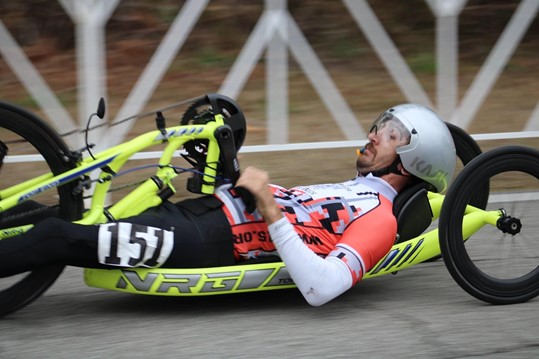Top End is a Florida-based designer and manufacturer of adaptive sports equipment, including handcycles, racing chairs, basketball chairs, and other equipment designed for physically impaired athletes.
Many Top End customers compete or train at the highest levels, and the company is constantly seeking ways to improve their customers’ comfort and results. Few parts on a handcycle are more important than the hand pedal, which is used to drive, steer, and control braking on the device.

Faced with labor and production challenges due to COVID-19, Top End turned to additive manufacturing, or 3D printing, which allowed them to develop innovative hand pedals that can incorporate features (like braking and shifting for either hand) and be customized for multiple products used by even the most demanding elite athletes.
When Top End was ready to manufacture their new innovative hand pedals, they turned to The Technology House (TTH).
Top End was striving to create a more ergonomic design, which wasn’t possible using welded aluminum.
After the Top End team developed an ideal shape with foam, they began modeling the part, tweaking it as necessary until they had a prototype ready for hundreds of hours of testing.
The Top End team uses 3D printing because it's extremely useful for taking a concept like the hand pedal to manufactured reality. Top End's engineers adhere to an iterative process to refine 3D-printed parts and then print them in-house for testing.
"3D printing is a differentiator," said Top End Engineer Stephen Zuravel, explaining that Top End is the only provider of scale in the industry using 3D printing to make parts more accessible to more consumers.
“We’re able to show customers that we are constantly innovating and using technology to deliver the best possible products,” he said.
While the design was originally slated for production on the highest-end handcycles Top End produces, they quickly discovered that the design was not only better for all users but that 3D printing allowed for faster, easier, and more cost-effective production.
Top End relies on outsourced 3D printers because they offer advanced manufacturing techniques. While they have in-house 3D printing capabilities, they're only for prototyping and not high-volume printing.
Top End met TTH through its corporate parent, Invacare, who works with TTH on other projects. They also reached out to TTH because they knew the company had deep experience in 3D printing for manufacturing applications similar to theirs. But what really convinced them was the level of service they received from TTH, said Zuravel.
“From the beginning, (Sales Manager) Owen (Timlin) helped find solutions,” he said. "TTH was proactive with their follow-up and with problem resolution.”
In the current environment of logistics challenges, supply chain headaches, and production issues, having a supplier like TTH that can reliably produce limited runs, meet deadlines and budget, and deliver on quality is incredibly valuable.
“For a smaller market like adaptive sports that’s growing, this is a great option,” said Zuravel. “3D printing helps us keep from having to go overseas, where it’s very hard to get smaller quantities, especially after COVID.”
The timing is another benefit, he said. The 3D-printed products can be made to order in a matter of minutes versus a multi-step conventional process that can take days—even without accounting for shipping times. They also require less expertise to assemble.
Finally, the total cost of each hand pedal—even with the higher quality and faster manufacturing—is more than 10% less than that of a conventionally made hand pedal. And that cost is likely to decrease as Top End begins using the hand pedal on more models.
"The benefits of 3D printing the hand pedal are considerable and lasting," Zuravel said. In addition to the savings of time and money, the products are of higher quality, offer more features, and are easier to service.
The 3D-printed hand pedal offers more comfort, which is important for athletes often competing or training over long distances. Top End says the part can easily be varied for shifting and brake configurations. The part can also be disassembled and repaired, unlike the prior generation of hand pedals.
The 3D-printed part is also a great foundation for future improvements, as the design allows for streamlined improvements that can be made without any new tooling.
Given the efficiency gains and improved outcomes, Top End expects to continue leveraging 3D printing more and more across its enterprise, said Zuravel.
“There are four or five other things that we’ve been playing around with here that are prototype versions now, but long-term we could absolutely see them being 3D printed.”
3D printing continues to grow in capability and possibility. It can make your manufacturing more efficient and effective while creating better products. The experts at TTH can show you how.
Headquarters
10036 Aurora-Hudson Road
Streetsboro, OH 44241
© 2025 The Technology House | Website by SyncShow | Privacy Policy